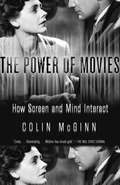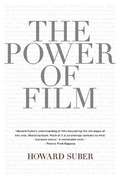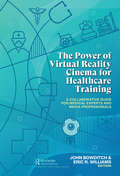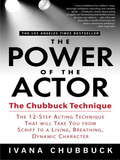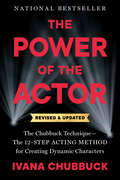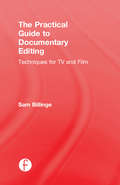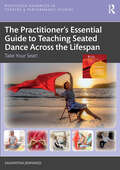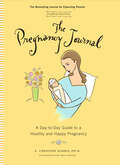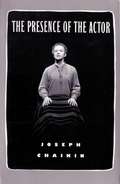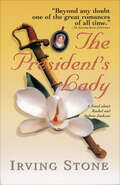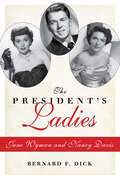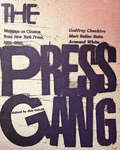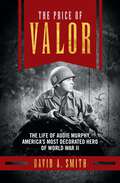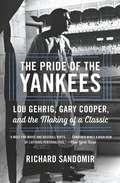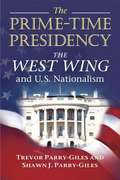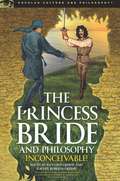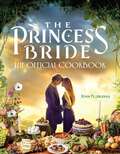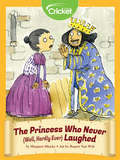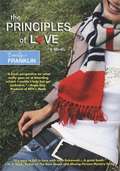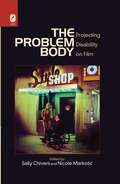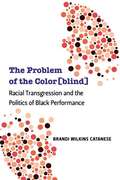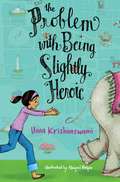- Table View
- List View
The Power Of Movies
by Colin McginnHow is watching a movie similar to dreaming? What goes on in our minds when we become absorbed in a movie? How does looking “into” a movie screen allow us to experience the thoughts and feelings of a movie’s characters? These and related questions are at the heart ofThe Power of Movies,a thoughtful, invigorating, and remarkably accessible book about a phenomenon seemingly beyond reach of our understanding. Colin McGinn–“an ingenious philosopher who thinks like a laser and writes like a dream,” according to Steven Pinker–enhances our understanding of both movies and ourselves in this book of rare and refreshing insight.
The Power of Film
by Howard SuberThis book examines the patterns and principles that make films popular and memorable, and will be useful both for those who want to create films and for those who just want to understand them better.
The Power of Virtual Reality Cinema for Healthcare Training: A Collaborative Guide for Medical Experts and Media Professionals
by Bob Fine Eric R. Williams John Bowditch Adonis DuradoCinematic Virtual Reality brings a combination of documentary, narrative and game design principles to the medical profession and, in the healthcare arena, collaboration is a key component for creating intellectually- and emotionally- rich immersive experiences. "The Power of Virtual Reality Cinema for Healthcare Training" gathers more than a dozen experts from both the production and healthcare fields to break down best practices for creating successful cine-VR projects. Designed for multi-disciplinary teams interested in integrating cine-VR production into their healthcare training and educational programs, this book has been written for two audiences: the healthcare professional interested in what production experts consider when approaching a project, and the media expert curious about how this new technology can be used in the medical field. Highlights include: Cutting edge medical education techniques developed by Ohio University’s GRID Lab, including: PREality (creating a forced sense of deja-vu to increase acclimation time), a unique approach to eye-tracking to enhance team performance, and the low-CRIS technique (a low-cost rapid implementation strategy to capture patient care for rapid graduate student training). Insightful production techniques that will enhance your cine-VR projects including advanced plating methods to hide lighting set-ups, immersive audio considerations, and new ways to consider 360 storytelling including the Lovrick montage and the Christmas Carol continuum for story development. Detailed explanations of the production considerations and results of specific cine-VR productions (from funding approaches to distribution) including access to more than five hours of cine-VR examples of the actual productions available for download. Details on a wide variety of medical cine-VR projects, including 100 images that illustrate best practices for topics such as recording in active medical facilities, building successful multi-disciplinary teams, working within HIPAA regulations, conceptualizing cine-VR libraries for graduate education, and implementing innovative distribution models.
The Power of the Actor
by Ivana ChubbuckIn The Power of the Actor, a Los Angeles Times bestseller, premier acting teacher and coach Ivana Chubbuck reveals her cutting-edge technique, which has launched some of the most successful acting careers in Hollywood. The first book from the instructor who has taught Charlize Theron, Brad Pitt, Elisabeth Shue, Djimon Hounsou, and Halle Berry, The Power of the Actor guides you to dynamic and effective results. For many of today's major talents, the Chubbuck Technique is the leading edge of acting for the twenty-first century. Ivana Chubbuck has developed a curriculum that takes the theories of the acting masters, such as Stanislavski, Meisner, and Hagen, to the next step by utilizing inner pain and emotions, not as an end in itself, but rather as a way to drive and win a goal. In addition to the powerful twelve-step process, the book takes well-known scripts, both classic and contemporary, and demonstrates how to precisely apply Chubbuck's script- analysis process. The Power of the Actor is filled with fascinating and inspiring behind-the-scenes accounts of how noted actors have mastered their craft and have accomplished success in such a difficult and competitive field. Praise for Ivana Chubbuck and The Power of the Actor"This is my bible. I don't leave home without it. "-Eva Mendes"Ivana Chubbuck is the premier acting coach of the twenty-first century. . . . Ivana's innovative methods of teaching both complement and rival those methods of the great teachers of the past. . . . Under Ivana's tutelage, the course of my career and depth of my work have changed dramatically. "-Halle Berry
The Power of the Actor, Revised and Updated: The Chubbuck Technique--The 12-Step Acting Method for Creating Dynamic Characters
by Ivana ChubbuckIn this completely updated edition of her bestselling book, renowned acting coach Ivana Chubbuck shares her cutting-edge technique that has launched some of the most successful and lauded acting careers in HollywoodLet the instructor who taught Halle Berry, Brad Pitt, Charlize Theron, Jim Carrey, Aubrey Plaza, Travis Fimmel, Gal Gadot, Beyoncé Knowles, Judith Light, Sylvester Stallone, Eva Mendes, Morris Chestnut, Shia LaBeouf, and Jake Gyllenhaal guide you to dynamic and effective results. With new stories from notable stars she&’s worked with since the first edition of The Power of the Actor and fresh exercises she&’s incorporated to upgrade her time-tested 12 step program, this revised edition, is a must-have for anyone looking to hone their craft.The Chubbuck Technique, takes the theories of acting masters such as Stanislavski, Strasberg, and Hagen to the next level by utilizing inner pain and emotions, not as an end in itself, but as a way to empower and fuel one&’s ability to overcome and win and therefore drive a unique and powerful performance. The Power of the Actor is filled with fascinating and inspiring behind-the-scenes accounts of how actors, writers, and directors have mastered their craft and accomplished success in such a difficult and competitive field.
The Practical Guide to Documentary Editing: Techniques for TV and Film
by Sam BillingeThe Practical Guide to Documentary Editing sets out the techniques, the systems and the craft required to edit compelling professional documentary television and film. Working stage by stage through the postproduction process, author Sam Billinge explores project organization, assembling rushes, sequence editing, story structure, music and sound design, and the defining relationship between editor and director. Written by a working documentary editor with over a decade’s worth of experience cutting films for major British and international broadcasters, The Practical Guide to Documentary Editing offers a unique introduction to the craft of documentary editing, and provides working and aspiring editors with the tools to master their craft in the innovative and fast-paced world of contemporary nonfiction television and film.
The Practical Guide to Documentary Editing: Techniques for TV and Film
by Sam BillingeThe Practical Guide to Documentary Editing sets out the techniques, the systems and the craft required to edit compelling professional documentary television and film. Working stage by stage through the postproduction process, author Sam Billinge explores project organization, assembling rushes, sequence editing, story structure, music and sound design, and the defining relationship between editor and director. Written by a working documentary editor with over a decade’s worth of experience cutting films for major British and international broadcasters, The Practical Guide to Documentary Editing offers a unique introduction to the craft of documentary editing, and provides working and aspiring editors with the tools to master their craft in the innovative and fast-paced world of contemporary nonfiction television and film.
The Practice of Public Art: Art, Space, And Social Inclusion (Routledge Research in Cultural and Media Studies #Vol. 14)
by Cameron Cartiere Shelly WillisThis exciting new collection of essays by practicing artists, curators, activists, art writers, administrators, city planners, and educators offers divergent perspectives on the numerous facets of the public art process. The volume also includes a useful graphic timeline of public art history.
The Practitioner’s Essential Guide to Teaching Seated Dance Across the Lifespan: Take Your Seat! (Routledge Advances in Theatre & Performance Studies)
by Samantha JenningsThis book is a seminal seated dance guidebook for global dance and health practitioners. Seated dance is an inclusive and diverse form of physical activity, suitable for all, regardless of age or disability.The book offers valid advice, inspiration and a wide range of tried and tested teaching and learning approaches to help practitioners succeed in the seated dance classroom, covering all ages and settings. This book introduces a potted historical journey of seated dance and subsequently guides the professional practitioner through the critical stages of setting up professional, safe and creative seated dance sessions. Research and evidence are gathered ‘in and on practice’ through the author’s dedicated dance career and teaching reflections as a Royal Academician of Dance (RAD) teacher and are underpinned by a theoretical background in mental health and wellbeing in education. It contains contributions by valued peers and professionals and extracts from research theorists in the field. ‘Take Your Seat’ is a career professional development Group-approved text (CPD) enabling the reader to claim personal and professional development points. The author places the art of seated dance at the centre of dance education, making it inclusive, diverse, accessible and justifiable in today's various dance arts and health settings.This book integrates the author's extensive experience in dance, contemporary mental health and wellbeing research and insights from esteemed peers. It empowers practitioners to embrace diverse perspectives, fostering an inclusive and forward-thinking dance environment.
The Precarious in the Cinemas of the Americas (Global Cinema)
by Constanza Burucúa Carolina SitniskyHistorically, cinema in the Americas has been signed by a state of precariousness. Notwithstanding the growing accessibility to video and digital technologies, access to the material means of film production is still limited, affecting the spheres of production, distribution, and reception. Equally, questions about the precarious can be traced in cultural and archival policies, film legislations, as well as in thematic and aesthetic choices. While conventional definitions of the precarious have been associated with notions of scarcity and insecurity, this volume looks at precariousness from a non-monolithic angle, exploring its productivity and potential for original, critical approaches, with the aim of providing new readings to the variedly rich and complex cinemas of the Americas.
The Pregnancy Journal: A Day-to-Day Guide to a Healthy and Happy Pregnancy
by A. Christine HarrisAn updated edition of the million-selling guide that accompanies you through the days, weeks, and months of your pregnancy.A modern classic translated into a dozen languages, The Pregnancy Journal provides daily entries that update you on your baby’s development—as well as guiding you through the best health and nutrition decisions for both of you.With more than a million-and-half copies sold worldwide, this one-of-a-kind guide is the ultimate resource for today’s expecting mother, now in its updated fourth edition.
The Presence of the Actor
by Joseph ChaikinChaikin, who directed the celebrated Open Theater in the '60s, kindled an emphasis on communal playmaking whose impact is still evident today. This conversational review of his efforts details his methods and reveals the struggles involved in the creation of some of the most exciting theatre of our time.
The President's Lady: A Novel about Rachel and Andrew Jackson
by Irving StoneIn this acclaimed biographical novel, Irving Stone brings to life the tender and poignant love story of Rachel and Andrew Jackson. "Beyond any doubt one of the great romances of all time." -- The Saturday Review of Literature
The President’s Ladies: Jane Wyman and Nancy Davis
by Bernard F. DickRonald Reagan, a former actor and one of America's most popular presidents, married not one but two Hollywood actresses. This book is three biographies in one, discovering fascinating connections among Jane Wyman (1917–2007), Ronald Reagan (1911–2004), and Nancy Davis (b. 1921–2016). Jane Wyman, who married Reagan in 1940 and divorced him seven years later, knew an early life of privation. She gravitated to the movies and made her debut at fifteen as an unbilled member of the chorus, then toiled as an extra for four years until she finally received billing. She proved herself as a dramatic actress in The Lost Weekend, and the following year, she was nominated for an Oscar for The Yearling and soon won for her performance in Johnny Belinda, in which she did not speak a single line. Other Oscar nominations followed, along with a Golden Globe for her portrayal of Angela Channing in Falcon Crest. Conversely, Nancy Davis led a relatively charmed life, the daughter of an actress and the stepdaughter of a neurosurgeon. Surrounded by her mother's friends—Walter Huston, Spencer Tracy, Katharine Hepburn, Lillian Gish, and Alla Nazimova, her godmother—Davis started in the theater, then moved on to Hollywood, where she enjoyed modest success, and finally began working in television. When she married Reagan in 1952, she unwittingly married into politics, eventually leaving acting to concentrate on being the wife of the governor of California, and then the wife of the president of the United States. In her way, Davis played her greatest role as Reagan's friend, confidante, and adviser in life and in politics. This book considers three actors who left an indelible mark on both popular and political culture for more than fifty years.
The Press Gang: Writings on Cinema from New York Press, 1991-2011
by Godfrey Cheshire Armond White Matt Zoller SeitzA dialogue about cinema's legacy and best directors through essays by three of the best long-form critics out there, collected from the legendary NYPress for the first time.Comprising of the kind of long-form criticism that is all too rare these days, the weekly film columns in the NYPress included polemics, reviews, interviews, festival reports and features. A far cry from what is often derisively termed the "consumer report" mode of criticism, Cheshire, Seitz and White were passionately engaged with the film culture of both their own time, and what had come before. They constituted three distinctly different voices: equally accomplished, yet notably individual, perspectives on cinema. Their distinctive tastes and approaches were often positioned in direct dialogue with each other, a constant critical conversation that frequently saw each writer directly challenging his colleagues. Dialogue is important in criticism, and here you can find a healthy example of it existing under one proverbial roof. This three-way dialogue between Cheshire, Seitz and White assesses the 1990s in cinema, along with pieces on New York's vibrant repertory scene that allow us to read the authors' takes on directors such as Hitchcock, Lean, Kubrick, Welles, Fassbinder and Bresson; as well as topics such as the legacy of Star Wars, film noir, early film projection in New York City, the New York Film Critics Circle, Sundance, the terrorist attacks of 9/11 and the emerging cinema of Iran and Taiwan.
The Price of Valor: The Life of Audie Murphy, America's Most Decorated Hero of World War II
by David A. SmithWhen he was seventeen years old, Audie Murphy falsified his birth records so he could enlist in the Army and help defeat the Nazis. When he was nineteen, he single-handedly turned back the German Army at the Battle of Colmar Pocket by climbing on top of a tank with a machine gun, a moment immortalized in the classic film To Hell and Back, starring Audie himself. In the first biography covering his entire life--including his severe PTSD and his tragic death at age 45--the unusual story of Audie Murphy, the most decorated hero of WWII, is brought to life for a new generation.
The Pride of the Yankees: Lou Gehrig, Gary Cooper, and the Making of a Classic
by Richard SandomirOn July 4, 1939, Gehrig delivered what has been called "baseball's Gettysburg Address" at Yankee Stadium. There is, for now, no known, intact film of Gehrig's speech, but instead, just a swatch of the newsreel footage has survived, incorporating his opening and closing remarks: "For the past two weeks you have been reading about the bad break I got. Yet today I consider myself the luckiest man on the face of this earth," the last line, of course, having become one of the most famous, invoked, and inspiring, ever, anywhere. The New York Times account, the following day, called it "one of the most touching scenes ever witnessed on a ball field", that made even hard-boiled reporters "swallow hard." The scene and the story would likely have been largely lost to history, altogether, were it not for the film, Pride of the Yankees, best known for Gary Cooper, as the dying Lou Gehrig, movingly describing himself as "the luckiest man on the face of the earth," even as his body was being ravaged by the disease that was soon named after him. Here, now, in THE PRIDE OF THE YANKEES: Lou Gehrig, Gary Cooper, and the Making of a Classic by Richard Sandomir, New York Times sports columnist, is, for the first time, the full story behind the pioneering, seminal movie. Filled with larger than life characters and unexpected facts, Iron Hero shows us how Samuel Goldwyn had no desire to making a baseball film but he was persuaded to make a quick deal with Lou's widow, Eleanor, not long after Gehrig had passed; Hollywood icon Cooper had zero knowledge of baseball and had to be taught to play; unknown parts of the screen treatment and screenplay that will be written about for the first time; and dishy letters to Eleanor from Christy Walsh, the pioneering business manager who represented the Gehrigs, from the Los Angeles set. Nostalgic, breezy and fun, THE PRIDE OF THE YANKEES captures a lost time in film and sports history.
The Prime-Time Presidency: The West Wing and U.S. Nationalism
by Shawn J. Parry-GilesContrasting strong women and multiculturalism with portrayals of a heroic white male leading the nation into battle, The Prime-Time Presidency explores the NBC drama The West Wing, paying particular attention to its role in promoting cultural meaning about the presidency and U.S. nationalism. Based in a careful, detailed analysis of the "first term" of The West Wing's President Josiah Bartlet, this criticism highlights the ways the text negotiates powerful tensions and complex ambiguities at the base of U.S. national identity--particularly the role of gender, race, and militarism in the construction of U.S. nationalism. Unlike scattered and disparate collections of essays, Trevor Parry-Giles and Shawn J. Parry-Giles offer a sustained, ideologically driven criticism of The West Wing. The Prime-time Presidency presents a detailed critique of the program rooted in presidential history, an appreciation of television's power as a source of political meaning, and television's contribution to the articulation of U.S. national identity.
The Princess Bride and Philosophy: Inconceivable!
by Richard Greene Rachel Robison-GreeneThe Princess Bride is the 1987 satirical adventure movie that had to wait for the Internet and DVDs to become the most quoted of all cult classics. <P><P> The Princess Bride and Philosophy is for all those who have wondered about the true meaning of "Inconceivable!," why the name "Roberts" uniquely inspires fear, and whether it's truly a miracle to restore life to someone who is dead, but not necessarily completely dead. The Princess Bride is filled with people trying to persuade each other of various things, and invites us to examine the best methods of persuasion. It's filled with promises, some kept and some broken, and cries out for philosophical analysis of what makes a promise and why promises should be kept. It's filled with beliefs which go beyond the evidence, and philosophy can help us to decide when such beliefs can be justified. It's filled with political violence, both by and against the recognized government, and therefore raises all the issues of political philosophy. Westley, Buttercup, Prince Humperdinck, Inigo Montoya, the giant Fezzik, and the Sicilian Vizzini keep on re-appearing in these pages, as examples of philosophical ideas. Is it right for Montoya to kill the six-fingered man, even though there is no money in the revenge business? What's the best way to deceive someone who knows you're trying to deceive him? Are good manners a kind of moral virtue? Could the actions of the masked man in black truly be inconceivable even though real? What does ethics have to say about Miracle Max's pricing policy? How many shades of meaning can be conveyed by "As You Wish"?
The Princess Bride: Official Cookbook
by Jenn Fujikawa"As you dish!" Few films have captured the hearts and imaginations like The Princess Bride. Based on the book by William Goldman, the 1987 film, directed by Rob Reiner and starring Cary Elwes, Robin Wright, Mandy Patinkin, Billy Crystal, Andre the Giant, Carol Kane, Chris Sarandon, Wallace Shawn, Christopher Guest, Fred Savage, and Peter Falk is as universally beloved as it is quotable. Now, for the first time, The Princess Bride Cookbook: The Official Cookbook features more than 50 recipes for dishes seen in, and inspired by, the film, including: Buttercup Buttermilk Scones Hash You Wish Farm Boy Breakfast Six-Fingered Sandwiches Chips of Insanity MLT The Grandson&’s Soup and Sandwich Vizzini&’s Sicilian Meatballs Fezzik&’s Stew The Spaniard&’s Paella Bread Pirate Roberts Twu Wove&’s Kiss Cookies Iocane Powder Punch Inigo Montoya&’s Taste of Revenge Perfect for fans, families, and Brute Squads, The Princes Bride: The Official Cookbook is the ultimate way for home cooks to plate up the adventure, comedy, and romance of everyone&’s favorite film.
The Princess Who Never (Well, Hardly Ever) Laughed
by Margaret MincksA king becomes upset because his daughter never laughs and because she turns away all the men who want to marry her. When will someone come along who truly delights her?
The Principles of Love
by Emily FranklinThe Gilmore Girls meets The Sisterhood of the Traveling Pants in this fun, sophisticated teen novel about the lovable Love Bukowski. First in a brand-new series. The "movie version" of Love Bukowski's life is picture perfect. She can roll out of bed and be at class in her new prep school within minutes because she lives in an amazing house on Hadley Hall Campus, where her Dad just happens to be the principal. And though she's just joined the ranks of the nation's future leaders and lushes of America, they've all become her best friends. Gorgeous upperclassmen crowd around her doorstep just to catch a glimpse of her performing her original songs. Life is sweet! Unfortunately, the not-so-glamorous reality of her life is that her Dad is the principal of the this prototypical New England prep school. Friends are hard to come by, and the only guys who come near her front door are the ones she wants to swat away. Not that there's a shortage of Hadley hotties; it's just that the one Love's singled out is an utterly incredible and totally unattainable senior. Now, Love will have to figure out the true meaning of her name to make her reality as awesome as her fantasies.
The Problem Body: Projecting Disability on Film
by Sally Chivers Nicole MarkoticEditors Sally Chivers and Nicole Markotic bring together the work of eleven of the best disability scholars from the U.S., the U.K., Canada, and South Korea to explore a new approach to the study of film by concentrating on cinematic representations of what they term "the problem body." The book is a much-needed exploration of the projection of disability on film combined with a much-needed rethinking of hierarchies of difference. The editors turned to the existing corpus of disability theory with its impressive insights about the social and cultural mediation of disabled bodies. They then sought, from scholars at every stage of their careers, new ideas about how disabled bodies coexist with a range of other bodies (gendered, queered, racialized, classed, etc.). To call into question why certain bodies invite the label "problem" more frequently than other bodies, the contributors draw on scholarship from feminist, race, queer, cultural studies, disability, and film studies arenas. In Chivers and Markotic's introduction, they draw on disability theory and a range of cinematic examples to explain the term "problem body" in relation to its projection. In explorations of film noir, illness narratives, classical Hollywood film, and French film, the essays reveal the "problem body" as a multiplication of lived circumstances constructed both physically and socially.
The Problem of the Color[blind]: Racial Transgression and the Politics of Black Performance
by Catanese Brandi Wilkins"Catanese's beautifully written and cogently argued book addresses one of the most persistent sociopolitical questions in contemporary culture. She suggests that it is performance and the difference it makes that complicates the terms by which we can even understand 'multicultural' and 'colorblind' concepts. A tremendously illuminating study that promises to break new ground in the fields of theatre and performance studies, African American studies, feminist theory, cultural studies, and film and television studies. " ---Daphne Brooks, Princeton University "Adds immeasurably to the ways in which we can understand the contradictory aspects of racial discourse and performance as they have emerged during the last two decades An ambitious, smart, and fascinating book. " ---Jennifer DeVere Brody, Duke University Are we a multicultural nation, or a colorblind one? The Problem of the Color[blind] examines this vexed question in American culture by focusing on black performance in theater, film, and television. The practice of colorblind casting---choosing actors without regard to race---assumes a performing body that is somehow race neutral. But where, exactly, is race neutrality located---in the eyes of the spectator, in the body of the performer, in the medium of the performance? In analyzing and theorizing such questions, Brandi Wilkins Catanese explores a range of engaging and provocative subjects, including the infamous debate between playwright August Wilson and drama critic Robert Brustein, the film career of Denzel Washington, Suzan-Lori Parks's play Venus, the phenomenon of postblackness (as represented in the Studio Museum in Harlem's "Freestyle" exhibition), the performer Ice Cube's transformation from icon of gangsta rap to family movie star, and the controversial reality television series Black. White. Concluding that ideologies of transcendence are ahistorical and therefore unenforceable, Catanese advances the concept of racial transgression---a process of acknowledging rather than ignoring the racialized histories of performance---as her chapters move between readings of dramatic texts, films, popular culture, and debates in critical race theory and the culture wars.
The Problem with Being Slightly Heroic
by Uma Krishnaswami Abigail HalpinDini is back from India--with Bollywood star Dolly in tow! But life in the States isn't all rose petal milk shakes...Dini and Maddie, very best friends, are back in the same country at the same time! Better still, Dolly Singh, the starriest star in all of Bollywood, is in America too. Dini's only just returned from India, and already life is shaping up to be as delicious as a rose petal milk shake. Perfect. Then why can't she untie the knot in her stomach? Because so much can go wrong when a big star like Dolly is in town. All Dini has to do is make sure Dolly has everything she needs, from a rose petal milk shake to her lost passport to...a parade? And an elephant? Uh-oh... It's time to think. What Would Dolly Do? If Dini can't figure it out, Dolly might take matters into her own hands--and that will surely lead to the biggest mess of all! Uma Krishnaswami has concocted a delicious sequel to her multiple star-reviewed The Grand Plan to Fix Everything, which Kirkus Reviews called "a delightful romp."
